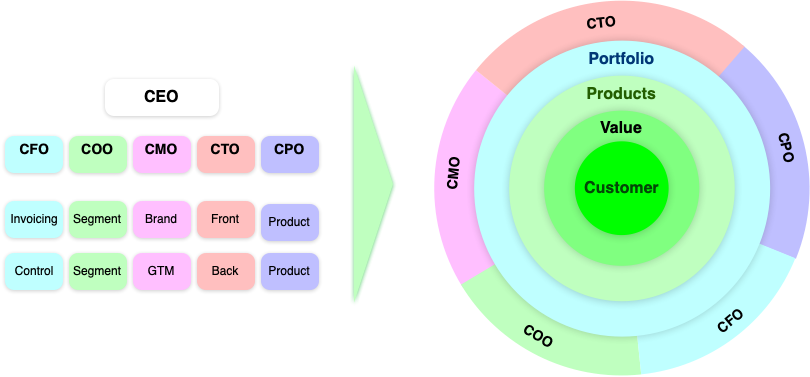Why you need to lead Digital Transformation through customer-centric portfolio evolution | Digital Transformation
The digital and AI revolution is a process accelerating the emergence of new opportunities and threats in every market. This uncovers new strengths and exposes new weaknesses in your business all the time. I propose new goals for Customer-centric Agile Digital Transformation to face this fact.

Whether you're a Chief Executive Officer (CEO), a Chief Financial Officer (CFO), a Chief Technology Officer (CTO), or even a Head Corporate Legal Counsel (CLC) or Managing Partner of a Law Firm, you need to have a strategy to navigate the new AI-driven marketplaces and leverage digital opportunities.
First, let's be clear on one thing: Digital Transformation is a legacy business problem. In both senses of the term:
- It's a problem for legacy businesses
- It's an old problem
Are there any sizable businesses today that have not already "gone digital"? Anyone still doing their invoices on paper? Well, probably, but is that a major challenge of business today? Obviously not.
So why are we still going on and on about it?
Because like most business concepts and buzz-words, it's an ill-defined term. Like all ill-defined terms, it carries a lot of weight: people load it with the content that matters to them. So let's clarify what I mean.
There's two kinds of Digital Transformation for legacy businesses:
- There's the kind where you take existing well-known business processes, and use new digital technology to make them more efficient, or get rid of them entirely. You do RPA for invoice processing, automate the employee evaluation lifecyle and emailing campaigns and so on. That's the old problem. There's still a lot of work to be done, but it's a well-known scope that doesn't change the nature of the value chain you're operating in or the structure of the supply chain that you have in place.
- Then there's the kind where you look at your profitable, established business, and try to figure out what the next step of your business is going to be. Maybe it's because you see disruption coming in, maybe it's because you see new opportunities, but either way: it's about changing your business model.
When I talk about Digital Transformation here, I'm talking about the latter: emerging, technology-enabled opportunities and threats that need to be addressed. These force you to look differently at your businesses' core strengths and weaknesses.
Is it that you see an opportunity to capture an additional piece of the value chain? Or that your slice of the value chain risks getting smaller? Or that additional value can be created, and it better be by you? Either way, once you start addressing this, your business will start to change.
Portfolio-first Digital Transformation...
This is the reason why you need to drive your forward-looking Digital Transformation through the evolution of your product portfolio: if you're not making changes to the value that you are creating for the market, then you're not creating opportunities, you're not deflecting threats.
You're not creating value.
And of course, this value creating Digital Transformation is the one that's hard. Why?
Because it requires change to the business model, to the supply chain, to operations, to product design and ultimately to your entire organization. Traditional supply and value chains are driven by complex logistics, each piece of which requires deep and specific expertise to make it run. They depend on different laws of physics, different socio-economic determinants, different optimization equations.
Emerging digital tech these days is different, it's like new physics have suddenly appeared in the universe, that impact every piece of the supply chain in similar ways. It's about real-time situational awareness, using together data about things that used to be independent. It's about speeding up or parallelizing certain parts of the value chain.
All this radically changes where the bottlenecks are in your supply chain and therefore the time-to-market equation.
Yet, your legacy organization likely has a structure that adapted organically over time to optimize for logistical bottlenecks that existed before the digital and AI revolution. This is why the digital AI revolution is so uniquely disruptive.
You know as a business leader of a legacy company that the organizational structure, i.e. the result of the old world optimization, largely determines, or significantly constrains, what products you can build. New value routinely gets postponed or cancelled on account of the way your organization has split and siloed expertise over time. A new feature that would create value for your clients requires deep integration or synchronicity between pieces of the supply chain that live in different silos, some of which all of a sudden need to introduce a new deliverable in their workflow, and therefore it doesn't get to market.
What the digital AI revolution brings, among other things, is a radically new ability to analyze demand, which enables you to better predict what the market needs. This give you the ability to plan ahead for what your supply chain needs to adapt for.
... needs a configurable supply chain
Solving this problem requires organizational change that is hard to anticipate. Moreover, tech moves so fast these days that the need for the ability to change has to be built in to your organization. No more historical legacy silos of expertise doing their thing.
You need Agile teams whose core capability is the capacity to reconfigure expertise, redeploy resources, pivot deliverables as new constraints emerge or old ones disappear.
The trick is to find what needs to stay stable. Not every part can be moving without a stable target. An organization needs to be efficient, which means having the optimal amount of moving parts given the expected result.
Now then the question is: what is the expected result? I contend that the expected result is:
- A stable but evolving value proposition
- An Agile and reactive product development
- A dynamic and reconfigurable supply chain
In other words, what needs to stay stable is the tip of the spear: the value delivered by the portfolio to the market. The porfolio will evolve, change, be pruned and enriched with new features and offerings, but this will be done in order to keep the value proposition complete and relevant in a changing context.
The supply chain will be reconfigured for agility rather than taken as a given.
We need to think of our organizations as value optimizing machines. Putting our value-driven portfolio at the front, and letting it drive a much flatter and configurable set of teams and units that keep producing new things, can pivot and reallocate resources dynamically.
For a decade or so, we focused a lot on "configurable products", reusable assets and so on, but we mostly accepted that they had to work off of the legacy supply chain, with some tweaks. Let's face it: this is not sustainable.
An organization cannot go through endless successive Digital Transformation programs every time the market discovers a new piece of added value somewhere.
Let's build reconfigurability and personalization into the supply chain rather than having to work around it. That's the only way to have a truly agile product portfolio that responds to market needs because, at the end of the day, the portfolio is where the company's market value is realized.
As an added bonus, this also provides a better context for integrating acquisitions and partnerships with startups and vendors.
Can we do this though?
Easier said than done, of course, and it applies differently to different industries. For massively capital intensive industries, whose business involves building assets for years that will stay in commission for decades, it will look very different than it will for the knowledge part of the economy.
Still, Zara is an interesting case in point here, as they understood this before anyone else. It's not a massively capital intensive business, but it's not a digital knowledge business either. The key to their success has been to focus their entire supply chain on the ability to respond immediately, practically daily, to shifting consumer demand. They did this before the AI revolution, although it was largely enabled by ERP tech.
Microsoft is an other interesting case: since it became a large company, ie in the 90s, Microsoft ran a 6-months strategy cycle where each cycle could, and often would, lead to significant reconfiguration of their product lines, go-to-market, marketing, development teams, basically the business, in response to changing strategic needs.
There are companies that have been doing this for a long time, very successful ones. So while it may look different for different businesses, the need for a reconfigurable supply chain has been around for decades, and the AI revolution is creating new and better opportunities for businesses to take that view.
To conclude, modern businesses will need to recognize that adaptability is a sort reservoir of value, a meta-value-creation, that needs to be mastered in order to remain competitive. This goes far beyond having an innovation pipeline or digitizing existing workflows.
It means getting on top of AI and MLOps, inventing new X-Ops for Agile knowledge supply-chain configurability, and dedicating teams of business experts and engineers to maintaining the ability to adapt, not just maintaining the business as usual of new product development.
Are we up for it?
Find out more about my thoughts on implementing customer-centric Agile Digital Transformation:

Who am I?
I'm Vincent Henderson, Chief Product Officer, Chief Digital Officer or Chief Operations Officer for knowledge-driven businesses. I lead the complete knowledge value chain, from sourcing to processing, delivery, product design and Product Management.



Comments